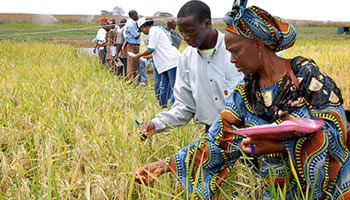
Last week, finance ministers and central bankers from around the world gathered in Washington for the World Bank and International Monetary Fund semi-annual spring meetings to promote sustainable and equitable growth. Six years after the beginning of the global financial crisis, prospects for a strong recovery are still not optimistic; conversations for the most part focused on the stabilization and revitalization of a sluggish economy, and the role fiscal and monetary policies, financial regulation, and debt relief can play within countries.
Largely missing from the discussion was the role of labor in achieving long-term economic stability, underscoring the disconnect between the world’s financial elite and the needs of job-seekers in their respective constituencies. Asia, for example, owes a good portion of its economic success in the latter half of the twentieth century to a massive working age population, which was able to turn the region into the agricultural and manufacturing force it is today. Along with building Asia’s economy to its current state and decreasing dependency ratios, economists predict that young working age Asians were responsible for as much as 25 to 40 percent of the region’s achieved economic growth in the last fifty years. Its youth bulge produced a momentum that continues to move 100 million people into the middle class each year.
A large working age population was key to the economic development of many current world powers; however, today’s economic giants are all aging, some much faster than others. The proportion of youth in Germany, Italy, Japan, China, and South Korea is shrinking quickly, bringing into question whether the size of their future working age professionals will be large enough to support welfare and social security programs, let alone sustain current economic success. By 2050, the dependency ratios of all G7 countries will almost double, and nearly triple for Italy and Japan. With trends showing that fertility rates will only decrease and longevity increase, the world’s most prosperous countries must look elsewhere for labor capital.
Unlike much of Europe and Asia, Africa’s demographic future remains dominated by a still-growing youth population. The number of young people in Africa—who make up more than 60 percent of the continent’s population—is expected to double by 2045. Africa’s labor force will be larger than China’s by 2035 and India’s by 2045. African youths are becoming more educated than ever before, with the percentage of secondary school graduates rising from 42 today to 59 percent by 2030. As subscriptions to mobile phone services rise to 650 million across the continent, smart phones are introduced, and internet usage parallels that of Brazil or China, Africa’s young are more connected than ever before. The proliferation of mobile banking systems to bridge gaps in the physical infrastructure is illustrative of the innovative and entrepreneurial spirit that exists.
African youth are not only the future of the continent, but of the global economy. With the aggregate number of conflicts in Africa reaching an all-time low, and the continent being home to six of the ten fastest growing economies in the world, Africa is becoming a hot spot for foreign investment. By 2016, the continent’s spending power will rise by at least 25 percent, and by 2050, one in every four working person will be African. The McKinsey Global Institute reports that “the rate of return on foreign investment is higher in Africa than in any other developing region.”
Undoubtedly, it is Africa’s growing population, as well as its recent political and economic progress, that has invited a surge of interest from countries such as China, India, Turkey, and Brazil. Of the estimated $9.3 billion China invested in Africa in 2010, 42.3 percent went to services and another 22 percent went to manufacturing, with only 29.2 percent directed toward extractive industries—a demonstration of the country’s interest in building human capacity on the continent. South Korea recently partnered with Malawi to launch a Youth Job Creation Initiative, which sent 1,000 young men and women to South Korea to be trained in agriculture and livestock development, serving as a gateway for tapping into Malawi’s labor force.
Still, much needs to be done in order to turn Africa’s youth bulge into a global demographic dividend. Large numbers of Africans, especially young Africans, currently remain unemployed or underemployed: a mere 7 percent of youth in low income African countries have stable salaried jobs. Ten to twelve million African youths enter the workforce each year, but in the past decade, Africa has only been able to absorb approximately 16 percent of these workers. Certain leaders, such as Malawian President Joyce Banda, realize the urgency of job creation on the continent, and have worked to develop skills training programs to better prepare young people for the demands of the workforce. Last week in Johannesburg, the government of South Africa signed a youth employment accord, also aimed at aligning the skills of job seekers with the needs of the labor market. However, public expenditure on vocational training in most African countries is negligible, with government response more rhetorical than substantive.
As World Bank Africa region Vice President Makhtar Diop emphasized at the opening of the meetings last week, “the key challenge for African Governments is to convert [the continent’s] growth into jobs.” Africa is faced with an unprecedented opportunity to leverage the underdeveloped potential of its youth to turn the continent into powerhouse of youthful human capital amongst its aging peers, but it will be a long journey. Demographic trends show that domestic and international governments and investors have a huge stake in the future development of African youth, and an integrated response from public and private sectors may be enough to create a win-win situation that would benefit Africans, businesses, and the global economy.
Adrienne Chuck is an assistant director with the Africa Center at the Council. Photo credit: Afronline.
Image: africasglobaladvantage.jpg

